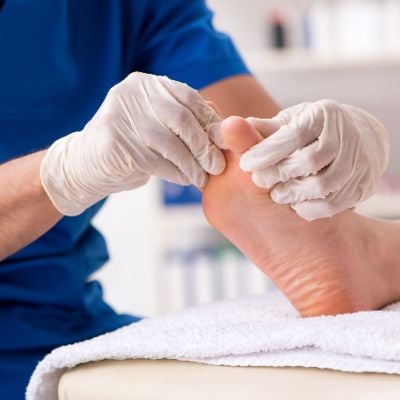 Acrocyanosis, a captivating yet enigmatic vascular phenomenon, casts a bluish spell on the extremities, captivating our attention and inviting us to unravel its mysteries. This article zooms in on acrocyanosis in the foot, exploring the intricacies of this condition, from its causes to symptoms and management. Join us on a journey into the world of peripheral vascular health, where the bluish hue tells a story waiting to be understood.
Acrocyanosis, a captivating yet enigmatic vascular phenomenon, casts a bluish spell on the extremities, captivating our attention and inviting us to unravel its mysteries. This article zooms in on acrocyanosis in the foot, exploring the intricacies of this condition, from its causes to symptoms and management. Join us on a journey into the world of peripheral vascular health, where the bluish hue tells a story waiting to be understood.
Understanding Acrocyanosis in the Foot
A Chromatic Intrigue
Acrocyanosis in the foot is a captivating display of bluish discoloration, predominantly affecting the toes and soles. Unlike other forms of cyanosis, acrocyanosis often emerges as a benign condition, rooted in the intricate dance of blood vessels that supply oxygen to our extremities.
Causes of Acrocyanosis in the Foot
Vascular Dynamics at Play
The fundamental cause of acrocyanosis in the foot lies in the intricate dynamics of blood vessels. Small arteries and arterioles constrict, restricting blood flow and, consequently, the delivery of oxygen to the affected areas. This localized hypoxia manifests as a distinctive bluish tint.
Idiopathic and Secondary Factors
While acrocyanosis often appears without a discernible cause (idiopathic), it can also be secondary to underlying medical conditions. Connective tissue disorders and neurological issues may contribute to the development of acrocyanosis in the foot, adding layers to its diagnostic and management complexities.
Delving into Symptoms
A Persistent Bluish Palette
The hallmark symptom of acrocyanosis in the foot is persistent bluish discoloration. This coloration is particularly pronounced in colder temperatures, where the vasoconstrictive response intensifies, highlighting the connection between external conditions and symptomatology.
Chill and Dampness
The affected foot often feels colder and damper than usual. This sensory alteration stems from reduced blood flow and compromised oxygen delivery to the skin, impacting its normal warmth.
Sensations of Pain and Discomfort
Some individuals with acrocyanosis in the foot may experience sensations of pain or discomfort. This can vary from a mild ache to more noticeable sensations, especially in response to exposure to cold conditions.
Diagnosis: A Clinical Canvas
Visual Examination
Diagnosing acrocyanosis in the foot begins with a visual examination. Healthcare providers keenly observe the bluish discoloration, assessing its persistence and intensity. A hands-on approach, literally feeling the temperature of the affected foot, adds valuable nuances to the diagnostic canvas.
Differential Diagnosis
Distinguishing acrocyanosis from other causes of cyanosis is a crucial aspect of the diagnostic journey. Conditions such as Raynaud's phenomenon and peripheral arterial disease may share similarities, necessitating a meticulous approach and sometimes additional diagnostic tests.
Imaging Studies: Unveiling the Vascular Tapestry
In certain cases, healthcare providers may recommend imaging studies such as Doppler ultrasound. This non-invasive technique provides a real-time glimpse into the blood flow dynamics of the affected foot, contributing to a more precise diagnosis.
Managing Acrocyanosis in the Foot
Embracing Lifestyle Modifications
For individuals with mild acrocyanosis in the foot, lifestyle modifications can be instrumental. Keeping the foot warm through appropriate footwear and avoiding prolonged exposure to cold conditions are simple yet effective strategies to alleviate symptoms.
Pharmacological Interventions
In cases where symptoms are more pronounced, pharmacological interventions may come into play. Vasodilators, medications that relax blood vessels and improve blood flow, may be prescribed to counteract vasoconstriction and mitigate the bluish discoloration.
Addressing Underlying Conditions
If acrocyanosis is secondary to an underlying medical condition, addressing that condition becomes paramount. Treating connective tissue disorders or managing neurological issues may contribute significantly to the improvement of symptoms in the foot.
Living with Acrocyanosis in the Foot
A Generally Benign Landscape
The overall prognosis for individuals with acrocyanosis in the foot is reassuringly positive. While the condition may persist, it typically doesn't lead to severe complications. With appropriate management, individuals can maintain a good quality of life.
Regular Monitoring and Self-Care
Regular monitoring and self-awareness become essential aspects of living with acrocyanosis in the foot. Being attuned to any changes in symptoms and adhering to self-care practices, such as keeping the foot warm, ensures a proactive approach to managing the condition.
Conclusion
In conclusion, acrocyanosis in the foot is a captivating facet of peripheral vascular health, and understanding its nuances is pivotal for affected individuals. Beyond the bluish hue lies a narrative of vascular dynamics, where each discoloration tells a tale of oxygen supply and demand. By shedding light on acrocyanosis in the foot, we aim to empower individuals to navigate its mysteries, seek appropriate care, and stride confidently toward a chromatically harmonious future.
Disclaimer:
The information on this website is provided for educational and information purposes only and is not medical advice. Always consult with a licensed medical provider and follow their recommendations regardless of what you read on this website. If you think you are having a medical emergency, dial 911 or go to the nearest emergency room. Links to other third-party websites are provided for your convenience only. If you decide to access any of the third-party websites, you do so entirely at your own risk and subject to the terms of use for those websites. Neither Viera Podiatry, nor any contributor to this website, makes any representation, express or implied, regarding the information provided on this website or any information you may access on a third-party website using a link. Use of this website does not establish a doctor-patient relationship. If you would like to request an appointment with a health care provider, please call our office at (321) 253-4973.


